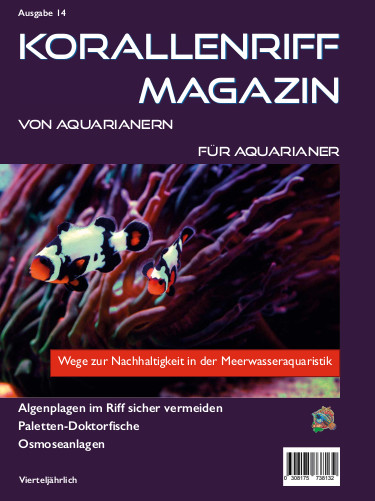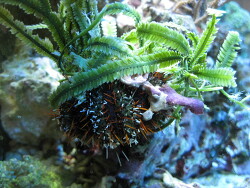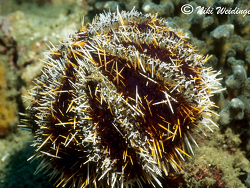Info
Tripneustes gratilla is also known as the Sea Egg, Priest-hat and the Hairy Pincushion Urchin. It has five or ten double rows of white and red spines separated by spaces of red, purple, white or black. To camouflage itself, it often covers itself with rocks, sponges, shells, or algae.
It prefer tanks with live rock so that it can graze on algae and just in case you have a problem with Caulerpa algae these urchins work wonders in aquariums that suffer from filamentous algae infestation, consuming this undesirable algae quickly.
Synonyms:
Cidaris angulosa Leske, 1778
Cidaris variegata Leske, 1778
Echinus (Tripneustes) sardica auct.
Echinus fasciatus Lamarck, 1816
Echinus gratilla Linnaeus, 1758
Echinus inflatus Blainville, 1825
Echinus pentagonus Lamarck, 1816
Echinus peronii Blainville, 1825
Echinus subcaeruleus Lamarck, 1816
Echinus variegatus (Leske, 1778)
Echinus virgatus Des Moulins, 1837
Evechinus australiae Tenison-Woods, 1878
Hipponoe nigricans A. Agassiz, 1863
Hipponoe sardica (L. Agassiz & Desor, 1846)
Hipponoe variegata (Leske, 1778)
Hipponoe variegata var. alba Tenison-Woods, 1883
Hipponoe violacea A. Agassiz, 1863
Tripneustes (Hipponoe) variegasta (Leske, 1778)
Tripneustes (Hipponoe) variegasta (Klein, 1734)
Tripneustes angulosus (Leske, 1778)
Tripneustes bicolor Perrier, 1869
Tripneustes fuscus Michelin, 1862
Tripneustes grabella
Tripneustes lorioli Lambert & Thiéry, 1914
Tripneustes pentagonus (Lamarck, 1816)
Tripneustes sardicus L. Agassiz & Desor, 1846
Tripneustes subcaeruleus (Lamarck, 1816)
Tripneustes variegatus (Leske, 1778)
Tripneustes zigzag Michelin, 1862







 Henning
Henning























